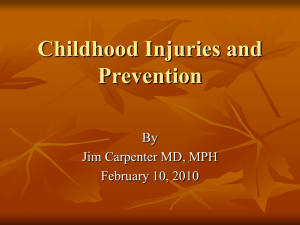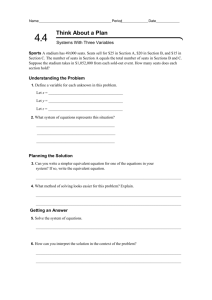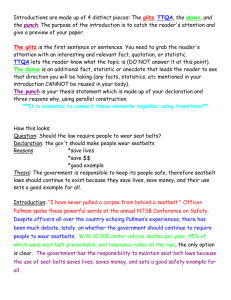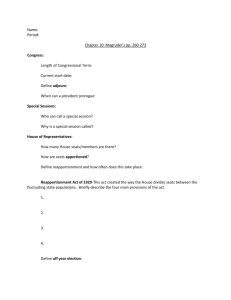Anticipating Safety
advertisement
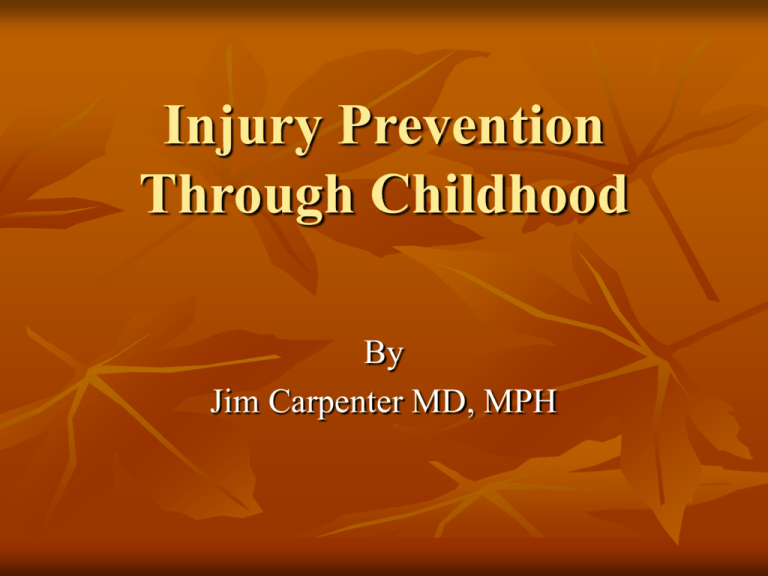
Injury Prevention Through Childhood By Jim Carpenter MD, MPH Goals Discussion about child safety and the Physician role in Anticipatory Guidance Data on Child Injury Anticipatory Guidance for safety: why and what to say Questions Anticipatory guidance Recent lit review:18 of 20 studies showed positive effects from injury prevention counseling 60% of parents report never receiving injury prevention counseling TIPP American Academy of Pediatrics taskforce entitled The Injury Prevention Program TIPP components Policy statement saying safety counseling is a priority and standard of care for PCP’s Provides counseling schedule which suggests age appropriate topics for each well child visit Materials for PCP’s including a Framingham Safety survey as well as info sheets TIPP too TIPP encompasses 11 visits between 0-4yrs. Survey to be completed 2, 15,24 mos. and they allow PCP to tailor counseling Topics are: Safety seats, smoke detectors, crib safety, water safety, firearms, pedestrian, play equipment, fall prevention, burn prevention, choking, suffocation prevention, and poisoning prevention TIPP cost Only takes 22 min of PCP’s time over 4 years thus adding an avg. of 1.5 min to the WCC visit (estimated as 16min long in 1992) Materials from AAP provided at $1.09 per child TIPP Benefit medical costs saved $5.50 per visit, $60 per child, 230 million annually at national level Work (wages lost to parents not included) $15.50 per visit, $170 per child, 660 million annually Quality of Life $59 per visit, $650 per child, 2.5 billion annually Were did those #’s come from? Effectiveness of broad prevention counseling in a suburban office reduced child injury rate by 15.3%. National medical expenditure survey shows avg. injury cost $394 per 1st 5 yrs of a child’s life Preventing permanent disabilities and death allows kids to work as adults Injury reduces quality of life. Took ratio of QOL cost to wage loss to injured in data from safety seats and smoke detectors yields QOL savings Why care about injury prevention National Health Interview Survey data determined an injury rate of 25/100 kids through 0-21yrs of age (26.6 million injuries per year) Estimate cost $347 billion annually 5 leading causes of PNM in US per CDC records1988-1998 Annual rate of the leading specific cause of injury hospitalization and death / 100K by 3 month intervals 0-4 yrs CA 1996-1998 Newborn Safety Sleep position and location Microwave heating Animals/pets Crib Water temperature Car Seat Avoid direct sunlight; unable to move or change position Layering of clothing Never leave alone in vehicle, extreme heat and extreme cold can kill Remove guns from home. If not then store guns and ammo separately with trigger locks Don’t leave infant alone with pets Post neonatal Deaths From 1988-1998 12,209 post neonatal (28-364 days of age) deaths occurred avg. 1110/year Majority unintentional injury due to mechanical suffocation i.e. wedging, oronasal obstruction by a plastic bag, overlying in bed, falling earth, lack of air in enclosed space, and accidental hanging obstructive suffocation from aspiration motor vehicle crash related deaths Car Seat Anticipatory Guidance In 1994, 673 kids less that 5 yrs of age killed, 362 unrestrained. Rear facing until 20lbs and 1 yr of age to decrease risk of cervical spine injury Back seat only Infant seats should not have shields, abd pads, or arm rest that can directly contact face In rear facing, shoulder straps should be lower than infants shoulders, clip should be mid sternum Car seat continued If child’s head leans forward in rear facing car seat, chair should be reclined until head against back of chair Convertible seat at 20 lbs and greater than 12 mos. Should be semi upright and forward facing (ears below top of back of seat and shoulders below the seat strap slots) Booster seat to position lap and shoulder strap. Lap across hips and shoulder strap below neck 2-6 Weeks Car Seats Crib safety Sleep Position Sibling jealousy Smoke detectors Bathwater Rolling over Infant should always sleep on back to reduce risk of SIDS Avoid sofa, soft mattress, waterbeds, comforters, crib pads, pillows, quilts. Co-sleeping(bed-sharing) increase risk of SIDS and suffocation by 20% or more. Parents should not smoke, drink, take sedating meds Non skid surface for baths Hot water heater should be at 120 degrees Never leave new infant alone with sibling under 7. Observe interactions. Children under five should not lift a younger sibling Smoke detectors should be on each floor of the house. Check batteries monthly. Change batteries yearly(landlords are responsible in many municipalities) Hot water and burns Hot water of 140F takes 6 sec for full thickness burns in adult Hot water 150 takes 2 seconds for full thickness in adults 120 takes 2 min to achieve full thickness in adult 1.5 to 4 Months Baby Walkers Toys Rolling/falls Infant seat safety Cribs Car Safety Crib slats- should be narrower than 2 and 3/8th inch(soda can) 1994 AAP recommend ban on walkers, CPSC reports more injuries than any other juvenile device. Decrease visual feedback Babies can wiggle, kick, scoot never leave alone on surface. Pillow barriers do not prevent falls and may cause suffocation No hot liquids and baby in your arms If baby gets burned, cool water, loose bandages, call MD Falls Leading cause of nonfatal injury Fatalities usually from heights >2 stories. If not fatal 1/3 cuts and abrasions, fracture most common serious injury Fall less than two stories resulting in injury usually head first onto hard surface from caregiver’s arms or impact of caregiver onto infant 4-6 months Walkers Toys Infant Seats Rolling Car Seats Choking therapy Toys with small parts or that fit into a toilet paper roll pose a choking hazard Look for age appropriateness labeling on toys and follow it(ie. Not for use by < 3yo) Hard pieces of food are choking risks Gates to block stairs Encourage BLS, no blind finger sweep, back blows Pad coffee table and sharp corners 6-9 Months Walkers Toys/Choking Drowning Stairs/gates Crawling Child proof the house Hand to mouth activity Plug covers Burns Walkers let kids get to dangerous areas, head and neck protrude unprotected for falls, can pull objects down on themselves Playpen/crib/ high chair are safe places while you are cooking Kids this age love water, leave no standing water, close door to bathroom or have toilet lock to prevent drowning Hand to mouth exploration leave no small objects or poisonous items within reach Crawl through house, great perspective to help child proofing 9-12 months Burns Car seats Bath safety Poisoning Child proofing Kitchen safety Aspiration risks Hand to mouth activity Stairs/gates Pedestrian injuries: 1-2 yrs old most likely backed over in driveway Highest over all rate of injury 495/100K in California in 1997 Never leave alone in bath, even with bath ring, do not leave in reach of fixtures Post poison control number(1-800-876-4766 or 1800-8POISON) Lock away all med and cleaners (remind other care givers as well). Kitchen, bathroom, purses. Turn handles of pots inwards, use back burners, kids in playpen or high chair, not under foot, 3 foot safety zone from stove 15-18 Months Bathtub safety Electrical cords Smoke detectors Falling/tripping Hot water temp Climbing Most likely fatal fall is from a windows >2 stories Remove furniture from windows, install operable window guards Virtually all kids less than 6 can slip through 6 inch railing opening (none older that 1 can get through 4 inch opening) Unplug appliances when not in use. Keep cords tied back and out of reach Kids love to climb to demonstrate new abilities and reach enticing objects. Anchor book shelves. Keep chairs away from counters etc 18 –24 Months Electric wires Electric outlets Car seats Climbing Bath time Pica/lead Ask about lead in home. CBC and Lead level. Sooner if hx of lead exposure. Discourage play near old paint. Remember increased risk with remodeling, car repair, Greta, Azarcon Outlet plugs for higher outlets. Consider covers that require better fine motor and more strength 24-30 Months Car seats Electric outlets Knives/guns Locks on doors and cabinets Car safety Second highest rate of injury in California in 1997 387/100K Re-iterate car seat safety. Forward facing. If out growing then booster seat. Locks on sliding doors and window guards. Consider door jam bumper guards 30-36 Months Car seats Electrical outlets Locks on doors Knives/guns Smoke detectors Outdoor safety Poisoning Water temperature Pedestrian injuries: 3-4 yrs old most likely injured in mid-block street entry accidents just like older kids Out door safety includes cross streets, play ground equipment with proper supervision, boundaries of the yard 4 year old Bike helmets Electrical outlets Fire lighting Smoke detectors Poisoning Outdoor safety Fire plan to escape home and meeting place should be developed and practiced Bike helmet should be purchased with bike. Appropriate size, chin strap should be used. Reduce serious injury risk by 85% Teach about match safety. No matches/lighters in reach. Do not ride bike in the street 5-6Year Old Seatbelts Electrical tools Bike helmet Guns Animal safety Name and Address Swimming Lock up dangerous items Street safety Street crossing safety, no crossing without adult Avoid strangers. Kids should be able to memorize name, address, phone (cell), parent’s name Peak age for injury from falls related to playground equipment 35/100K in CA 1997 Also balconies and fire escapes are fall dangers. Boys 1.5:1 girls for rate of falls Appropriate age for swimming lessons No power tools until age ten. Proper safety gear if helping a parent (i.e. eye protection) How to approach animals. Never approach an animal while eating Car Booster seats until 6 years or 60 pounds(8 years or 80 pounds). Rear seat until 12 years. 7-8 year old Bike/skating Skateboards Seatbelts Learn to swim Guns Bike/Skating Skateboards Seatbelts Smoke detectors Learn to swim Guns Drowning Proper safety gear for inline skating and skateboarding No wrist guards for scooters Guns-telling adult without touching Drowning- always supervise water activities 10-13 Years Old Bike/Skating/ Skateboards Seatbelts Learn to swim Guns/Knives Smoking, EtOH, drug avoidance Reporting sexual advances, computer safety Puberty talk Abstinence vs. safe sex, Plan B Supervise water activities Supervise power tool usage Do not ride with driver if they are drinking Do not operate ATV until age 16 Conflict resolution without violence Adolescent 14-21 Violence Seatbelts Guns 14-15 Years Old Protective gear for sports Illicit drug use and risk of OD Driving deaths and drowning risk with EtOH Violence- Gun deaths reach 25/100K at age 14 in CA. 50/1000K at 15 yrs, peaks at 110 at 18 yrs for 1997. No one under 16 should operate personal water craft 16-18 Years Old Seatbelts Driving safety-markedly higher rate of fatal crashes, risk increases further with increasing passengers Drugs Safe sex and date rape, Plan B California 1997 18 yr olds with highest rate of injury per year by age 732/100K Summary Take the opportunity to counsel about safety to help prevent injury, disability, and medical costs Prompts are great, but only if they actually help you Car safety Fall risks Poisonings Bibliography Agran P, Anderson C, Winn D, Trent R, Walton-Hayes L, Thayer S. Rates of pediatric injuries by 3-month intervals for children 0-3 years of age. Pediatrics 2003;111:6 Agran P, Winn D, Anderson C, Trent R, Walton Hayes L. Rates of pediatric adolescent injuries by year of age. Pediatrics. 2001;108:3 Committee on Injury and Poison Prevention AAP et. al. Falls from heights: windows, roofs, and balconies. Pediatrics. 2001;107:5 Committee on Injury and Poison Prevention AAP et. al. Selecting and using the most appropriate car safety seats for growing children: guidelines for counseling parents. Pediatrics. 1996;97:5 Miller T, Galbraith M. Injury prevention counseling by pediatricians: a benefit-cost comparison. Pediatrics. 1995:96:1 Shrivastava L, Shrivastava N. Anticipatory guidance. Clinics in Family Practice. 2003;5:6 Tomashek K, Hsia J, Iyasu S. Trends in post neonatal mortality attributable to injury, united States, 1988-1998. Pediatrics. 2003,111:5 Website: www.aap.org/family/tippmain.htm Acknowledgement This talk was modified from “Anticipating Safety” by Matthew Kraus MD Questions?
